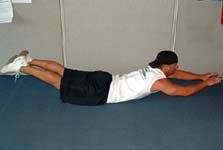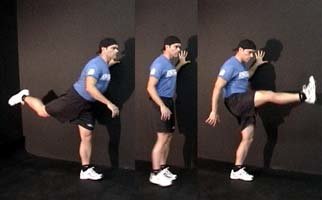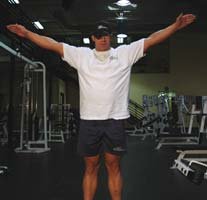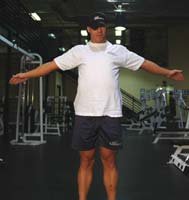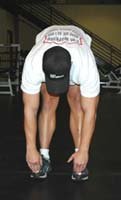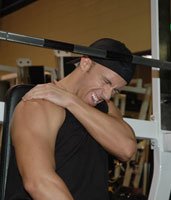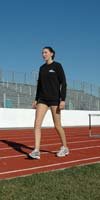
TOPIC: What Are The Best Pre/Post Workout Methods To Prevent Injury?

The Question:
If taking a few minutes before and after a workout can help reduce the risk of injury, then it's well worth it.
What are the best pre/post workout methods to prevent injury? Be Specific.
Does the use of saunas, steam rooms or hot tubs reduce the chance of injury? Benefit or Not?
Bonus Question: How much time do you spend before and after a workout to help reduce the risk of injury?
Show off your knowledge to the world!
The Winners:
- 1. soundcheck129
- 2. Sportsman5
- 3. History in Effect
- 3. vanhalen984
Prizes:
- 1st place - 75 in store credit.
- 2nd place - 50 in store credit.

1st Place - soundcheck129
View This Author's BodySpace Here.

Regardless of the specific goals of those at the gym, everyone is ultimately there to get into better shape. And whatever that shape may be, it surely does not include injury. Thankfully, there are many simple steps that can be taken to avoid injuring oneself.

What Are The Best Pre/Post Workout Methods To Prevent Injury?

Pre-Workout Protocol
Listen To Your Body
- The
- process should actually begin before you even hit the gym - something that many people sadly overlook. The first thing you should do is to ensure that you're feeling up to exercise. If you're sore, coming off an injury, or haven't worked out before, you may want to consult a medical professional prior to exercise.
- Also, if you feel sick or tired, perhaps from lack of
- , you may want to refrain from hitting the weights - overexerting yourself when you're not feeling 100 percent may lead to injury.
Plan And/Or Review Your Goals
- Keeping a
- is a great way to meet others in the online community, but its primary function is providing a way to track your progress and obtain advice from others. Even a simple paper and pencil log will allow you to keep track of your lifts.
- By knowing what you have lifted in the past, you will have a better idea of how much weight you can lift today. While everyone wants to progress, BE REALISTIC. Don't expect to add 50 pounds to your bench press in two days. Know your limits and set reasonable goals.
Similarly, don't compare yourself to others. Even though your No-Xplode may have you feeling like Superman by the time you reach the gym, don't feel like you have to try and lift as much as someone more experienced than you.
- Another thing a log will allow you to do is observe what exercises you perform often - perhaps too often. You should try to add variation to your routine, as pattern overload - constant repetition of the same movement - can place a lot of stress on muscles and joints and lead to injury.
Find A Partner/Spotter
- In addition to supplying someone to socialize with and making an unfamiliar gym less intimidating, a
workout partner
- can keep an eye on your form and act as a spotter if you're having trouble. Plus, the encouragement of a partner may
motivate
- you to lift even more!
Know The Territory
- Before launching into a routine filled with unfamiliar exercises, check out the
exercise database
- to make sure you know what you're doing. This will help you ensure proper form - improper technique is a major source of injury.
Take Care Of Yourself
Nutrition
- is also a big part of injury prevention. Make sure you consume enough
calories
- to fuel your workouts - you don't want to run out of gas in the middle of a set!
If you're crunched for time, protein powders or weight gainers are convenient ways to squeeze in some extra calories. In addition, you may want to look into vitamins or a joint care supplement to battle wear and tear. Also, try to make sure you get enough rest at night and in between workouts - overtraining will only hinder your goals.
Warm Up With Cardio
- Whether it's running in place or pedaling an exercise bike,
- increases blood flow and lets your body know it's game time. You should
warm up
- PRIOR to stretching, as stretching 'cold' muscles can actually lead to injury, rather than help prevent it.
Stretch
- After you've got the blood flowing, it's time to
- . This will improve flexibility and prevent injury. Make sure to focus on parts of your body that have been injured in the past, as well as muscles you plan on working.
- Leg swings, lunges, arm circles and touching your toes are all simple stretches that will be helpful. Do NOT stretch until it hurts, and do NOT "bounce" to stretch further - this is called ballistic stretching and can cause injury. Stretching should be slow and controlled.
Warm-Up Sets
- Your last "
warm-up
- " should be in the form of a few reps before your working sets. This will get you more familiar with the lift and help you establish proper form and range of motion.

Post-Workout Protocol
- You may be exhausted after lifting, but the work isn't over yet!
Warm Down With Cardio
- You don't see
sprinters
- run 100 meters at top speed and then simply sit down, do you? Well then why should you? Chances are, your
heart is racing
- after a workout, and you can cause issues with it if you don't gradually ease into rest. Spending a few minutes on the treadmill can do a world of good.
Stretch
- Before your workout isn't the only time you need to
- . Stretching after exercise is beneficial as well, and can assist in the healing of micro tears in your muscles. Also, stretching will help drain lactic acid from the "pumped" muscle and reclaim its range of motion.
Fire And Ice
- If you're feeling sore after exercise, you should address this as soon as possible. Applying ice to problem areas, as well as making use of warming topical creams, can ease the discomfort and reduce tension in your muscles.
Replenish Yourself
Dehydration
- can lead to cramps and many other more serious health problems, so make sure you drink water to replace what you've sweated out. But that's not all you lose during exercise - electrolytes are also lost during sweat, so you may want to look into Gatorade or a similar beverage.
- In addition, your muscles won't grow if you don't provide them with enough fuel - so eat up! In addition to food, you may want to invest in some
- and
- to keep yourself in prime condition.
And don't skimp on sleep, either. This is when your body repairs itself and grows, so get a good night's slumber.
Happy Ending?
- A
massage
- may feel like a treat, but it can also help you prevent injury. Massages relax tension in muscles, and can aid in
recovery
- .
Don't Forget Your Most Important Muscle
- And that would be your
brain
- . I know
post-workout nutrition
- is important, but I shudder when people tell me about chugging down a shake "on the drive home." Muscle strains aren't the only injury you should be looking out for - don't drive distracted or with one hand on the wheel and one on a sandwich. Your body won't deteriorate if you wait ten minutes to eat.
- Also, if you feel too weak or tired, have a friend drive you or try to locate a trainer or medic if you feel strangely sick or feel you may have injured yourself.

Do Sauna's, Steam Rooms Or Hot Tubs Reduce The Chance Of Injury?
Sauna and steam room use is a hotly debated topic, no pun intended. While the heat and steam do help flush out toxins and lactic acid, overstaying your welcome in the steam room can dehydrate you. In more serious cases, it can lead to heat exhaustion or even a heat stroke when paired with strenuous exercise.
However, saunas can be relaxing - and reducing stress means reducing the release of hormones that work against muscle-building. In addition, saunas can increase blood flow. So, as it is with everything else, moderation seems to be the key.

How Much Time Do You Spend To Help Reduce The Risk Of Injury?
Warming up isn't the most enjoyable part of my workout, but I do try to devote ample time to it. Pre- and post-workout cardio is usually 5-to-10 minutes, often in the form of a bike ride or jog to the gym. If I do drive or walk, I try to spend about ten minutes on an inclined treadmill.
Stretching is usually a 10-minute event, as I try to target all of the major muscle groups and include static and dynamic stretches.
Also, I take a hot 10-minute shower after working out to flush out toxins and lactic acid, and also to make sure I don't smell bad later on in the day.
In addition, I am very devoted to my sleep. I strive for seven to eight hours, and usually keep some sleep aids in reserve to make sure I get my rest.

2nd Place - Sportsman5
View This Author's BodySpace Here.


Pre-Workout:
The first part of pre-workout injury prevention is to create a workout that suits your body type and history of injuries.
Not everyone can do barbell squats, deadlifts, and bench press. Knee, back and shoulder issues can prevent certain people from safely performing some of the core exercises.
Here are some examples of ways I have worked around injuries and disproportionate body parts:
- I often times do giant sets for shoulders. This involves doing a set for front, side, and rear delt all in a row. I find I get a much better pump than when I do each part of the muscle individually. The increased blood flow/pump helps reduce irritation in the shoulder.
 |
What Is A Giant Set? A giant set is much like a superset, but instead of two exercises back-to-back there are four exercises back-to-back. |
 |
 |
||
- I have found that super setting dumbbell flyes and dumbbell/barbell bench presses is a great way to recruit as much muscle fiber as possible without putting a lot of strain on the shoulders and elbows.
Instead of benching 200 pounds for 5 reps, I do a set of dumbbell flyes for 6-8 reps, then a set of bench for 6-8 reps with 150. This will take pressure off of the joints and make sure your chest fails on the final rep of bench, not your shoulders or triceps.
- I have relatively long thighs and short lower back, so I use the Smith machine for squats because balancing the barbell results in knee irritation from bending my knee too far forward. If using the Smith machine does not alleviate your knee problems, try holding a dumbbell between your legs instead of using a bar.
- In order to avoid knee problems that can result from constantly doing heavy squats, I often times use the Milos Sarcev style of leg training.
This involves doing giant sets and performing walking lunges in between exercises. For example, one set could consist of 8-10 reps on the leg press, then lunging over to the knee extension machine and doing a set of 10-12 reps, then finish by lunging over to the hack squat and doing 6-8 super slow reps (5-7 seconds for the negative and 5-7 seconds for the positive).
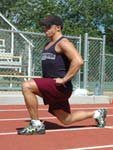
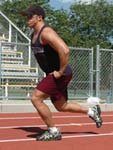
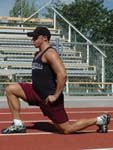
 Click To Enlarge.
Click To Enlarge.
Walking Lunges.
Video : Windows Media - MPEG
The second part of pre-workout injury prevention is the warm-up routine performed prior to exercising.
Prior to resistance training, one must do a thorough warm-up that includes cardio, stretching, and pumping up the muscle. The first step is to do 3-5 minutes of light to moderate cardio with a target heart rate of 110-130 BPM. The purpose of this is to increase the core temperature of the body and the blood flow to the muscles.
After cardio, it is time to do light stretching. The main goal of stretching before one lifts is to slightly increase the range of motion of the joints and flexibility of the muscles. This helps prevent muscle pulls and tendon strains.
Stretching each muscle to be worked for 20-30 seconds is fine. Keeping the stretching session short is essential because the longer you take to stretch, the cooler your body gets, and the less you will benefit from the warming effect and increased blood flow of the cardio.
The final part of the warm-up is the pre-workout pump. The sets performed for the pump are in addition to the warm-up set of 12-15 reps that most people do before performing a heavy set of a given exercise. The extra warm-up sets fully prepare the muscle to handle heavier weights and signal the body to lubricate the joints.
My warm-up sets for various body parts are as follows:

Biceps
- Dumbbell Curls: 2 sets of 20+ reps

Legs
- Knee/Leg Extension: 1 set of 25+ reps
- Leg Press: 1 set of 20+ reps

Chest
- Peck Deck: 1 set of 20+ reps
- Chest Press Machine: 1 set of 20+ reps

Tips
- Use a weight light enough so you are not at failure when you complete the chosen amount of reps. The light weight keeps strain off the joints and allows them to become lubricated before using a relatively heavy weight.
- Squeeze the muscle as hard as you can on each rep. The warm-up is all about pumping as much blood into the muscle as you can.
**If you experience chronic shoulder discomfort, then warm up the rotator cuff muscles before doing upper body exercises that involve the shoulder.
- Examples of warm-up exercises are
Bent-over reverse fly
- with dumbbells or cables and exterior rotation with either dumbbells or cables. Again, the reps should be in the 15-25 rep range and the sets should not be done to failure.

Post Workout:
Immediately after the main resistance training routine is the time to do physical therapy type exercises for areas of the body that are prone to injury. For example, internal and external rotator cuff exercises done to failure help to strengthen the shoulder and prevent rotator cuff strains/tears and subluxations or dislocations of the shoulder. Reps should range from 15-30.
Once the final exercise has been performed in the workout, then stretch the muscles that were worked in your resistance training routine. Hold each stretch for at least one minute. This is the time to elongate the muscle and stretch the fascia; elongating the muscle will decrease the chance of pulling or tearing the muscle.
The second step to post-workout injury prevention takes place outside of the weight room.
This is the time to use the services of professionals like chiropractors, massage therapists, physical therapists and acupuncturists.
Major injuries usually do not happen without warning. They usually begin as acute dull pains or slight soreness. If one ignores the early warning signs, and continues to train without an extended rest period or professional help, then the minor aches and pains can turn into tears, fractures or dislocations.
If one does experience even minor pain, then time should be taken off and ice should be applied to the area at least 2-3 times per day to help reduce inflammation. And if the pain continues for more than a few days, then a therapist should be contacted to deal with the specific problem.

Do Sauna's, Steam Rooms Or Hot Tubs Reduce The Chance Of Injury?
Saunas and steam rooms may feel great, however, they do not provide much in the way of injury prevention. Heat will help loosen muscles and tendons, so using a sauna just prior to training will theoretically help prevent strains and pulls while exercising. But beyond this, there is no significant benefit to using them post workout or between workouts.
Hot tubs are a little different. There are benefits to hot tubs if used in the correct way. For one, the jets in a hot tub can be used to massage back muscles. Tense back muscles are one of the leading causes of lower back and neck soreness.
Also, if you use the heat of the hot tub to your advantage, you can do stretches after soaking in the hot tub and really work on elongating tight muscles. The longer the muscle is the less likely it is to be strained or torn.

How Much Time Do You Spend To Help Reduce The Risk Of Injury?
Estimate of time spent on each injury prevention act:

Pre Workout
- Cardio - 3-5 Minutes
- Stretching - 2-4 Minutes
- Warm-Up Pump Sets - 2-4 Minutes
- Total: 7-13 Minutes

Post Workout
- Physical Therapy Exercises- 3-7 Minutes
- Stretching- 5-10 Minutes
- Total: 8-17 Minutes

3rd Place - History in Effect
View This Author's BodySpace Here.

There are various methods to reduce injury when it comes to bodybuilding, figure, and fitness training. A small minority of people I see in the gym have no idea how to prepare for a hard workout and in turn sadly have a higher percentage of getting injured. It is important to correct their workouts before their lack of preparation contributes to long-term injuries down the road. Injuries in the gym lead to high medical costs and who wants that? ... Nobody.

What Are The Best Pre/Post Workout Methods To Prevent Injury?

Stretch
- I would like to start off with pre-workout methods; they get the muscles ready for action. When I step into the gym, the first thing I do is to do some basic stretches. These include:
Arm Circles
Knee Lifts
As you can see, there is one exercise for my upper body and one for my lower body. This is just the first step in preparing for a workout.

Cardio
- After I am finished doing basic stretches, I get on the treadmill and run for 2-5 minutes at 1% incline and 3 mph. The purpose of this is to get my
heart rate
- going a little bit and get the muscles primed to work out. I use this technique to the fullest on leg days which is the body part that is the hardest to grow. Running at a low speed gets my
quads
- and
hamstrings
- amped-up for an intense workout.

Workout Room
- I tend to work one main body part during my workout, so I make sure to get an adequate
warm-up
- for the first couple of sets and then get into my actual workout. This also gets your muscles use to the weight instead of just piling it on at one time and lifting it.
- Now it's time for post-workout methods. These methods are just as important if not. You are fatigued after your workout and just having the normal post-workout shape is not enough.

Hydrotherapy
- The practice of hydrotherapy has been used for years. It involves alternating between cold and hot water in short bursts to speed up
recovery
- .
The contrast in temperature is not only relaxing and helps recovery, but also tests you mentally. Going from very hot to very cold is drastic change, so be prepared. The effect is that more blood is put into muscles which makes recovery faster. My muscles feel harder after coming out the shower. Here is the method I use:
- 45 Seconds Very Hot
- 45 Seconds Very Cold
Repeat this process 3 times. If I am going out somewhere, I like to finish on cold especially in the summer. I don't want to be hot and then be sweating on a hot Summer/Fall day in the South. Now, if I'm sleeping I fall asleep quicker finishing on warm, so that is what I do. Hydrotherapy helps the most for me on leg days.

Ice
- This is the most practical thing for a lot of people when they are sore after workout. Those sore muscles shrink back to normal size and also recover a little faster. Working out sometimes is about pain and the use of ice reduces the post-workout DOMS somewhat.
 |
What Does DOMS Stand For? DOMS is an acronym for Delayed Onset Muscle Soreness. |
 |
 |
||

Sleep (Of Course)
- Your body is rebuilding while you
sleep
- which translates into
recovery
- from your workouts. Pitiful Sleep = Little Energy = Failure in the workout room. A person who lacks enough sleep will have their sleep clock thrown into disarray and thus that can lead to increased sleep. This will all lead to weight gains.
When I only get 6 hours of sleep, I feel real sluggish and can barely get anything done. I get at least 7-to-10 hours and thus I feel fresh for the day and still going at night. Sleep is not something you can just not worry about, it's so necessary. Great sleep leads to a peaceful mind and physically you look better.

Chiropractor
- The last powerful weapon in your
preventing injury
- arsenal includes going to the
chiropractor
- . Chiropractors work wonders for many people especially when dealing with back pain. The back is such a big muscle and a large majority of workout you use your back in some way that could potentially hard it.
- Chiropractors help keep your spine aligned in the right way by addressing problems by massaging or putting vertebrae back in place. Insurance providers in growing numbers are including chiropractors on insurance policies, so the outrageous prices you hear from celeb chiropractors is much cheaper than normal. Your doctor is a good starting point as he/she can help you find a reliable person to reference you too.

Do Sauna's, Steam Rooms Or Hot Tubs Reduce The Chance Of Injury?
I personally cannot say so to this as I have not researched or have daily access to a sauna, steam room, or hot tub. A good source is an abstract from InfoWorld which analyzes whether tepid(hot) water makes a change in recovery from fatigue:
 View The Study Information Here.
View The Study Information Here.

How Much Time Do You Spend To Help Reduce The Risk Of Injury?
I spend 2 minutes stretching in the weight room, 5 minutes on the treadmill, and 5 minutes in the shower during hydrotherapy on average. I have not personally gone to a chiropractor, but I know others who I trust that have told me great things about them.
It is not about the quantity of time you spend, but about the quality of the time. You can jerk when you stretch or go soft when running treadmill. You came to the gym for a purpose so make sure you live that purpose out in preparation of the workout to the post-workout. Also, take in supplements if you find them useful.

3rd Place - vanhalen984
View This Author's BodySpace Here.

Let's face it, no one likes to get injured - trips to the doctor, missed workouts, expensive medical bills, and let's not forget the pain caused by the injury. All this makes getting injured a big event in one's life, while something so small, warming up, can prevent it.
Warming up before exercise and cooling down after is a simple, yet crucial aspect to injury prevention. It is essential that everyone warms up properly before their workout in order to prevent any injury from resulting.

What Are The Best Pre/Post Workout Methods To Prevent Injury?

Pre Workout
Heating Pad
- Placing a heating pad for 5-10 minutes on the muscles helps bring blood to the area to warm them up.
Light Aerobic Exercise
- This includes jump rope, exercise bike, treadmill, even jumping jacks; anything to get blood flow to the desired area.
Stretching
- helps bring blood to the muscles to prepare them for the upcoming exercises, probably the most well know way of warming up. Remember to NEVER stretch a cold muscle, this can actually INCREASE the risk of injury from pulls and tears. I recommend doing stretching only after you use one of the prior warm-up methods.
Warm-Up Sets
- Just because you've used a heating pad, done some
cardio
- , and stretched doesn't mean you're ready to find your max bench press. It is important to do light warm-up sets because jumping right into heavy weights can lead to injury, regardless of how much stretching you do. A good warm-up routine would look something like this:
- Work set 300 lbs, 5 Reps
- Warm-up Sets
- 95 lbs. 8 reps
- 135 lbs. 4 reps
- 185 lbs. 2 reps
- 225 lbs. 2 reps
- 270 lbs. 1 rep
I think you get the idea, just adjust the weights and reps accordingly. There is no exact way to warm up, just make sure you use lighter weight for more reps before the work set.

Post Workout
Ice Pack
- If you can use a heating pad to warm up, you can use an ice pack to cool down. Just place the ice pack on the muscle(s) worked during your workout for 5-10 minutes.
Stretching
- Same as before, but no need to worry about your muscles being warm, because now they're plenty warm from your workout.
Sleep
Sleep
- is one of the most important thing to recover quickly. I recommend 7-8 hours per night as the ideal amount. Sleep has plenty of benefits which we won't get into here, but just know that not getting the proper amount of sleep has a negative effect on recovery, which can lead to overtraining/injury.

Do Sauna's, Steam Rooms Or Hot Tubs Reduce The Chance Of Injury?
The regular sauna may not help with recovery, but scientists and doctors have discovered that radiant (infrared) heat can penetrate the body's tissues up to 2 inches deep and help heal injuries.
Special saunas with this type of heat are available through luxsauna.com. I do not recommend this as a way of recovery because they are expensive: a one person sauna costs $2,395, and I have not found any other studies or websites confirming the preceding claim that radiant heat helps.

How Much Time Do You Spend To Help Reduce The Risk Of Injury?
Personally, I spend no more than 5 minutes both before and after a workout to warm-up and cool down. Prior to my workout I jump rope for about 3 minutes and follow it up with some light stretching. I also make sure to do warm-up sets before I do my working sets to prevent any injuries, but I do not do much post-workout except maybe some stretching, and I make sure I get plenty of sleep every night.



